Operational Aspects of Electric Vehicles from Car-Sharing Systems
Abstract
1. Introduction
- external factors related mainly to the state of the infrastructure, availability of the infrastructure, climate, weather, and other factors that are beyond the control of users;
- indirect factors, which include for example appropriate route and vehicle selection;
- internal factors, related to the driver behavior, as well as parameters of used vehicle.
2. Car-Sharing and Electric Car-Sharing Systems—Main Issues
3. Research Experiment
3.1. Purpose and Description of the Experiment
- information about the examined object, i.e., type and its properties;
- definition the purpose of the research: cognitive, utilitarian or both.
- y—result factor;
- xk, xj—input parameters;
- b0, bk, bkk, bkj—regression coefficients.
3.2. Details for the Author’s Research Experiment on Electric Vehicles from Car-Sharing Systems and Used Methods
- The research used the vehicle most often used in car-sharing systems [65]. That car is characterized by the following parameters [66]:
- Maximum speed—135 (km/h);
- Battery capacity—41.0 (kWh);
- Engine power—109 (HP);
- Electric motor torque—220 (Nm).
The example of the electric vehicle from a car-sharing system is shown in Figure 3. - Based on the literature review [65,67] three main operating parameters relating to the electric vehicles were selected. They were defined as input factors controlled on a real scale as
- Travel time—(min);
- Distance—(km);
- Outside temperature—(°C).
- The experiment plan was created based on the d-optimal poly-selective experiment plan, which was supplemented with input values on a real scale. The values of the factors’ values were determined on the basis of data received from car-sharing system operators. These data determined:
- The length of travel routes most frequently covered by users of car-sharing systems;
- Outside temperature at the time of travel by car-sharing users;
- The times users covered certain travel routes.
- Measurements were made successively (journeys reflecting the conditions of using car-sharing vehicles) in accordance with the experiment plan presented in Table 2. Each journey was repeated five times;
- After each journey, parameter readings were recorded and stored in the vehicle’s on-board computer (Figure 4);
- The results of the research based on the presented experiment plan allowed to determine the dependencies of operational factors as a function of wear.
4. Results
- y—result factor;
- x1, x2, x3—input parameters;
- b0, b1, b2, b3, b11, b22, b33, b13, b12, b23—egression coefficients.
5. Discussion and Conclusions
- It is worth monitoring the energy consumption of vehicles by analyzing the users’ driving modes. On this basis, it is worth introducing a rewarding system for users who travel correctly with the vehicles. For example, offering them the opportunity to use services at a cheaper price or offering various types of rewards, also introducing elements of gamification;
- It is worth paying attention to the level of battery charging. And also it is important to initiating the charging of vehicle batteries within a certain range, depending on the specific vehicle type to achieve the 100% battery charge.
- It is worth choosing vehicles for the fleet based on real energy consumption and not on catalog values, which may significantly differ from real parameters;
- It is worth paying close attention to programs educating users on how to use electric vehicles. The conducted experiment indicates that proper education in the field of responsible driving of an electric car can realistically reduce the value of consumed electricity and, as a result, reduce the operating costs of the system.
Author Contributions
Funding
Conflicts of Interest
References
- The International Energy Agency. Global EV Outlook. Available online: www.iea.org/publications/reports/globalevoutlook2019/ (accessed on 1 August 2019).
- Ortar, N.; Ryghaug, M. Should All Cars Be Electric by 2025? The Electric Car Debate in Europe. Sustainability 2019, 11, 1868. [Google Scholar] [CrossRef]
- Noel, L.; de Rubens, G.Z.; Kester, J.; Sovacool, B.K. Vehicle-to-Grid. A Sociotechnical Transition beyond Electric Mobility; Palgrave MacMillan: Basingstoke, UK, 2019. [Google Scholar]
- Stević, Z.; Radovanovic, I. Energy Efficiency of Electric Vehicles. In New Generation of Electric Vehicles; Stević, Z., Ed.; InTech: Rijeka, Croatia, 2012; pp. 93–134. [Google Scholar]
- Jung, J.; Koo, Y. Analyzing the Effects of Car Sharing Services on the Reduction of Greenhouse Gas (GHG) Emissions. Sustainability 2018, 10, 539. [Google Scholar] [CrossRef]
- Baptista, P.; Melo, S.; Rolim, C. Energy, Environmental and Mobility Impacts of Car-sharing Systems. Empirical Results from Lisbon, Portugal. Procedia Soc. Behav. Sci. 2014, 111, 28–37. [Google Scholar] [CrossRef]
- Britton, E. Carsharing 2000 Report—Sustainable Transport’s Missing Link. J. World Transp. Policy Pract. Commons Ecoplan 2000. Available online: https://networkdispatches.files.wordpress.com/2013/10/carshare-2000-final-report.pdf (accessed on 2 August 2019).
- Min, X.; Qiang, M. Fleet sizing for one-way electric carsharing services considering dynamic vehicle relocation and nonlinear charging profile. Transp. Res. B Methodol. 2019, 128, 23–49. [Google Scholar]
- Cocca, M.; Giordano, D.; Mellia, M.; Vassio, L. Free floating electric car sharing design: Data driven optimization. Pervasive Mob. Comput. 2019, 55, 59–75. [Google Scholar] [CrossRef]
- Edrissi, A.; Askari, M.; Smaniotto-Costa, C. Electric-vehicle car-sharing in one-way car-sharing systems considering depreciation costs of vehicles and chargers. Int. J. Transp. Eng. 2019, 7, 127–138. [Google Scholar]
- Zhang, J.; Ying-Qi, L. Research on the Innovation of Electric Vehicle Time-sharing Rental Business Model in Beijing. In Proceedings of the 2017 International Conference on Economics, Management Engineering and Marketing, Wuhan, China, 20 October 2017; pp. 1–7. [Google Scholar]
- Biondi, E.; Boldrini, C.; Bruno, R. Optimal charging of electric vehicle fleets for a car sharing system with power sharing. In Proceedings of the 2016 IEEE International Energy Conference (ENERGYCON), Leuven, Belgium, 4–8 April 2016; pp. 1–6. [Google Scholar]
- Ning, D.; Jingjin, P.; Zhan, Z.; Yang, J. Life cycle assessment of car sharing models and the effect on GWP of urban transportation: A case study of Beijing. Sci. Total Environ. 2019, 688, 1137–1144. [Google Scholar]
- Folkestad, C.A.; Hansen, N.; Fagerholt, K.; Andersson, H.; Pantuso, G. Optimal charging and repositioning of electric vehicles in a free-floating carsharing system. Comput. Oper. Res. 2020, 113, 104771. [Google Scholar] [CrossRef]
- Miao, H.; Jia, H.; Li, J.; Qiu, T.Z. Autonomous connected electric vehicle (ACEV)-based car-sharing system modeling and optimal planning: A unified two-stage multi-objective optimization methodology. Energy 2019, 169, 797–818. [Google Scholar] [CrossRef]
- Hu, K.; Wu, J.; Schwanen, T. Differences in Energy Consumption in Electric Vehicles: An Exploratory Real-World Study in Beijing. J. Adv. Transp. 2017, 2017, 4695975. [Google Scholar] [CrossRef]
- Carroll, S.; Walsh, C. UK Electric Vehicle Case Studies. SAE Tech. Pap. 2011, 39, 7225. [Google Scholar]
- Bingham, C.; Walsh, C.; Carroll, S. Impact of driving characteristics on electric vehicle energy consumption and range. IET Intell. Transp. Syst. 2012, 6, 29–35. [Google Scholar] [CrossRef]
- Walsh, C.; Carroll, S.; Eastlake, A. UK electric vehicle range testing and efficiency maps. SAE Tech. Pap. 2011, 39, 7224. [Google Scholar]
- Li, W.; Stanula, P.; Egede, P.; Kara, S.; Herrmann, C. Determining the main factors influencing the energy consumption of electric vehicles in the usage phase. In Proceedings of the 23rd CIRP Conference on Life Cycle Engineering, LCE, Berlin, Germany, 22–24 May 2016; pp. 352–357. [Google Scholar]
- Zhang, R.; Yao, E. Eco-driving at signalised intersections for electric vehicles. IET Intell. Transp. Syst. 2015, 9, 488–497. [Google Scholar] [CrossRef]
- Ciari, F.; Bock, B.; Balmer, M. Modeling Station-Based and Free-Floating Carsharing Demand: A Test Case Study for Berlin, Germany. Emerging and Innovative Public Transport and Technologies; Transportation Research Board of the National Academies: Washington, DC, USA, 2014. [Google Scholar]
- Ferrero, F.; Perboli, G.; Rosano, M.; Vesco, A. Car-sharing services: An annotated review. Sustain. Cities Soc. 2018, 37, 501–518. [Google Scholar] [CrossRef]
- Nourinejad, M.; Roorda, M. Carsharing operations policies: A comparison between one-way and two-way systems. Transportation 2015, 42, 497–518. [Google Scholar] [CrossRef]
- Shaheen, S.; Chan, N.D.; Micheaux, H. One-way carsharing’s evolution and operator perspectives from the America. Transportation 2015, 42, 519–536. [Google Scholar] [CrossRef]
- Muheim, P.; Reinhardt, E. Car-Sharing: The Key to Combined Mobility. In Energy 2000; BFE Swiss Federal Office of Energy: Bern, Switzerland, 1998; pp. 58–71. [Google Scholar]
- Mindur, L.; Sierpiński, G.; Turoń, K. Car-Sharing Development—Current State and Perspective. Logist. Transp. 2018, 3, 5–14. [Google Scholar]
- Civitas Project, Car-Sharing. Available online: http://civitas.eu/car-independent/car-sharing (accessed on 20 March 2018).
- Shaheen, S.; Cohen, A. Innovative Mobility Carsharing Outlook Carsharing Market Overview, Analysis, and Trends Winter 2016; Transportation Sustainability Research Center—University of California: Berkeley, CA, USA, 2016. [Google Scholar]
- Car-sharing in Europe. Business Models, National Variations and Upcoming Disruptions. Monitor Deloitte. iss. 6, 2017. Available online: https://www2.deloitte.com/content/dam/Deloitte/de/Documents/consumer-industrial-products/CIP-Automotive-Car-Sharing-in-Europe.pdf (accessed on 20 March 2018).
- Turoń, K.; Sierpiński, G. Car-sharing in urban transport systems—Overview of Europe and Asia. In Challenges of Urban Mobility, Transport Companies and Systems, Proceedings of the 2018 TranSopot Conference, Sopot, Poland, 28–30 May 2018; Suchanek, M., Ed.; Springer: Cham, Switzerland, 2019; pp. 89–99. [Google Scholar]
- Car-Sharing System MoveAbout Operator’s Website. Car-Sharing System in Numbers. Available online: http://www.moveabout.no/Hjem (accessed on 25 February 2019).
- Car-Sharing System AutoLib’ Operators’ Website. Car-Sharing System in Numbers. Available online: https://www.tripsavvy.com/rent-an-electric-car-in-paris-with-autolib-1618918 (accessed on 25 February 2019).
- Car-Sharing System Car2Go Operator’s Website. Car-Sharing System in Numbers. Available online: http://www.care-north.eu/sites/default/files/Day%202_04_Amsterdam%20Research%20Results%20of%20Free-Floating%20Car-Sharing_Stephan%20Suiker_0.pd (accessed on 25 February 2019).
- Car-Sharing System PonyCar-Sharing Operator’s Website. Car-Sharing System in Numbers. Available online: http://0-100.hotnews.ro/2016/07/19/car-sharing-in-romania-pony-car-se-extinde-in-bucuresti-cu-bmw-i3-ce-fac-romanii-cu-masinile-inchiriate-le-spala-se-ataseaza-de-ele/ (accessed on 25 February 2019).
- Car-Sharing GreenMobility Operators’ Website. Car-Sharing System in Numbers. Available online: https://www.ey.com/Publication/vwLUAssets/EY_-_feature_QA_with_GreenMobility (accessed on 25 February 2019).
- Car-Sharing Emov Operator’s Website. Car-Sharing System in Numbers. Available online: https://www.emov.eco/madrid/?lang=en (accessed on 25 February 2019).
- Car-Sharing MoBee Operator’s Website. Car-Sharing System in Numbers. Available online: http://www.mobee.mc/fr/faq (accessed on 25 February 2019).
- Car-Sharing System Carloh Operator’s Website. Car-Sharing System in Numbers. Available online: https://www.carloh.lu/en/ (accessed on 25 February 2019).
- Car-Sharing System SpinCity Operator’s Website. Car-Sharing System in Numbers. Available online: https://www.spincity.hr/bonus-minute-za-tocenje-goriva/ (accessed on 25 February 2019).
- Car-Sharing ZenCar System Operator’s Website. Car-Sharing System in Numbers. Available online: https://www.spreds.com/en/financings/75-zen-car (accessed on 25 February 2019).
- Car-Sharing System Vozilla Operator’s Website. Car-Sharing System in Numbers. Available online: https://www.wroclaw.pl/miejska-wypozyczalnia-samochodow-elektrycznych-vozilla-juz-rok-we-wroclawiu (accessed on 25 February 2019).
- Car-Sharing 4 Mobility Operator’s Website. Car-Sharing System in Numbers. Available online: https://elektrowoz.pl/tag/bmw-i3-4mobility/ (accessed on 25 February 2019).
- Car-Sharing Elmo Rent Operator’s Website. Car-Sharing System in Numbers. Available online: http://www.elmorent.ee/en/2017/07/ (accessed on 25 February 2019).
- Car-Sharing Zity Operator’s Website. Car-Sharing System in Numbers. Available online: https://zitycar.es/en/ access: 25.02.2019 (accessed on 25 February 2019).
- Car-Sharing YouDrive Operator’s Website. Car-Sharing System in Numbers. Available online: https://youdrive.today/?geoip_city=saint%20petersburg (accessed on 25 February 2019).
- Car-Sharing Innogy Operator’s Website. Car-Sharing System in Numbers. Available online: https://wysokienapiecie.pl/8199-carsharing_elektrycznych_aut_innogy_warszawie_wynajem_na_minuty/ (accessed on 25 February 2019).
- Car-Sharing Traficar Operator’s Website. Car-Sharing System in Numbers. Available online: https://media.traficar.pl/40469-elektryczne-renault-zoe-w-traficarze-od-dzis-w-trojmiescie (accessed on 25 February 2019).
- Car-Sharing GreenGoo Operator’s Website. Car-Sharing System in Numbers. Available online: https://niezalezna.pl/247698-carsharing-aut-elektrycznych-rusza-w-katowicach (accessed on 25 February 2019).
- Car-Sharing eCar Operator’s Website. Car-Sharing System in Numbers. Available online: https://media.tauron.pl/pr/412317/w-katowicach-rusza-pilotazowy-carsharing-pojazdow-elektrycznych (accessed on 25 February 2019).
- Car-Sharing Panek Operator’s Website. Car-Sharing System in Numbers. Available online: https://panekcs.pl/aktualnosci/100-electric-w-carsharingu (accessed on 25 February 2019).
- Car-Sharing Spark Operator’s Website. Car-Sharing System in Numbers. Available online: https://sofiaglobe.com/2017/10/31/green-driving-in-sofia-spark-rents-out-electric-vehicles-per-minute/ (accessed on 25 February 2019).
- Car-Sharing Car4Way Operator’s Website. Car-Sharing System in Numbers. Available online: https://prague.tv/en/s72/Directory/c207-Travel/n11133-Electric-car-sharing-project-launches-in-Prague (accessed on 25 February 2019).
- Car-Sharing BCR Ego Operator’s Website. Car-Sharing System in Numbers. Available online: https://www.bcr.ro/ro/presa/informatii-de-presa/2017/11/22/car-sharing-prin-card-bancar-contactless-bcr-lanseaza-eGo-si-devine-prima-banca-din-romania-care-ofera-un-concept-inovator-de-car-sharing-electric (accessed on 25 February 2019).
- Car-Sharing GoCar Operator’s Website. Car-Sharing System in Numbers. Available online: https://www.gocar.ie/what-could-you-do-with-gocar/ (accessed on 25 February 2019).
- Car-Sharing Emov Portugal Operator’s Website. Car-Sharing System in Numbers. Available online: https://www.emov.eco/carsharing-futurodamobilidade/?lang=pt-pt (accessed on 25 February 2019).
- Car-Sharing Mol Limo Operator’s Website. Car-Sharing System in Numbers. Available online: https://mol.hu/en/about-mol/media-room/6534-mol-group-launches-car-sharing-service-in-budapest/ (accessed on 25 February 2019).
- Car-Sharing Aimo Operator’s Website. Car-Sharing System in Numbers. Available online: https://aimosolution.com/?lang=en (accessed on 25 February 2019).
- Car-Sharing Moov’in Operator’s Website. Car-Sharing System in Numbers. Available online: https://www.vaielettrico.it/moovin-paris-il-nuovo-car-sharing-di-parigi/ (accessed on 25 February 2019).
- Kacprzycki, B. Planowanie Eksperymentów. Podstawy Matematyczne; Wydawnictwa Naukowo-Techniczne: Warszawa, Polska, 1974. [Google Scholar]
- Polański, Z. Metodyka Badań Doświadczalnych; Państwowe Wydawnictwo Naukowe: Warszawa, Polska, 1978. [Google Scholar]
- Strzałkowski, A.; Śliżyński, A. Matematyczne Metody Opracowywania Wyników Pomiarów; Państwowe Wydawnictwo Naukowe: Warszawa, Polska, 1973. [Google Scholar]
- Polański, Z. Współczesne Metody Badań Doświadczalnych, Wiedza Powrzechna; Publisher: Warszawa, Polska, 1978. [Google Scholar]
- Turoń, K.; Kubik, A.; Łazarz, B.; Czech, P.; Stanik, Z. Car-sharing in the context of car operation. In Proceedings of the International Automotive Conference. KONMOT, Cracow, Poland, 13–14 September 2018; Institute of Physics Publishing: Bristol, UK, 2018; pp. 1–10. [Google Scholar]
- Imprensa—Renault. Technical Specification of Renault ZOE. Available online: http://www.imprensa.renault.com.br/upload/produto/ficha-tecnica/zoe_2016-02-11_18-23-09.pdf (accessed on 26 February 2019).
- Helmers, E.; Marx, P. Electric cars: Technical characteristics and environmental impacts. Environ. Sci. Eur. 2012, 24, 1–15. [Google Scholar] [CrossRef]
- Daina, N.; Sivakumar, A.; Polak, J.W. Modelling electric vehicles use: A survey on the methods. Renew. Sustain. Energy Rev. 2017, 68, 447–460. [Google Scholar] [CrossRef]
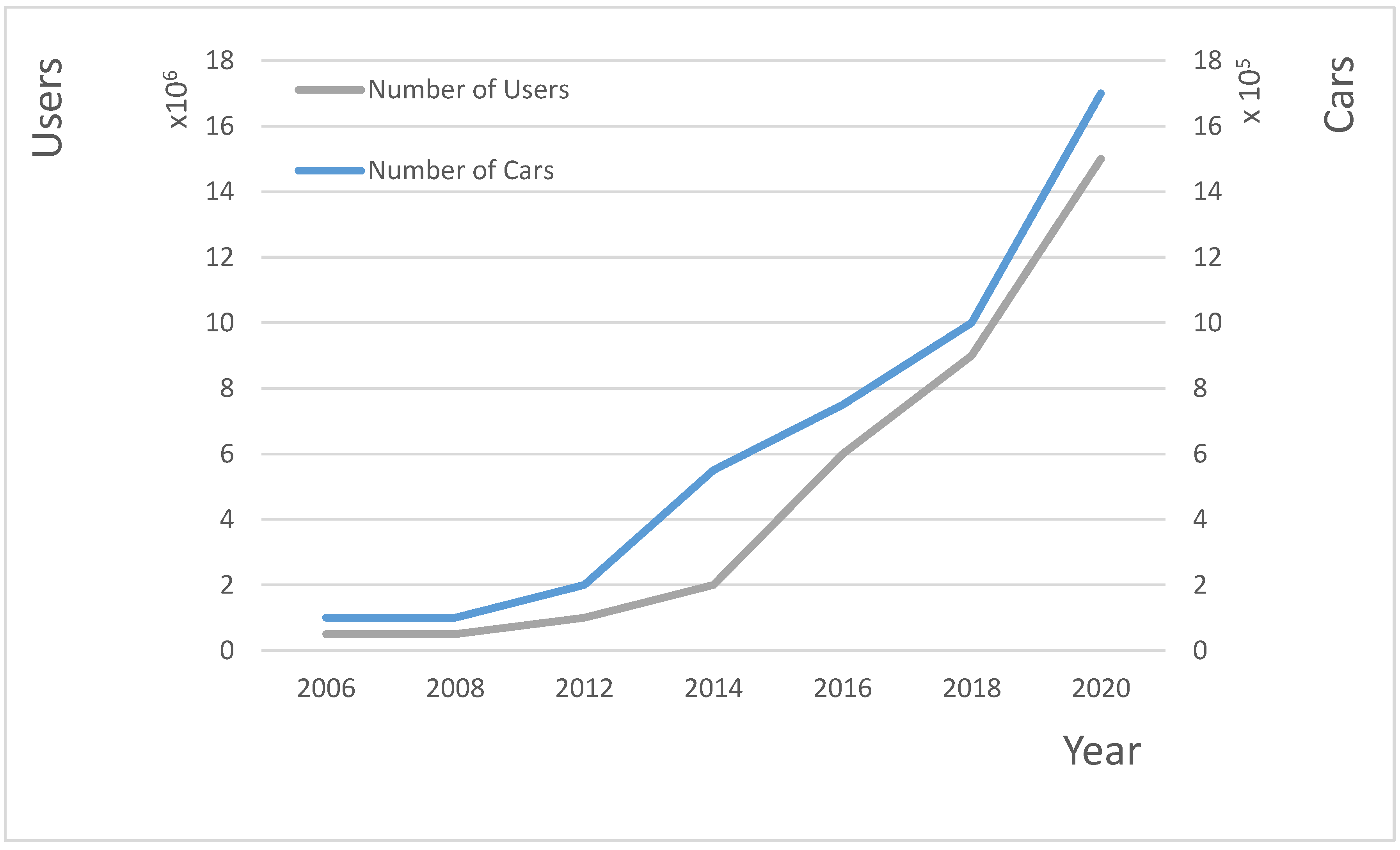
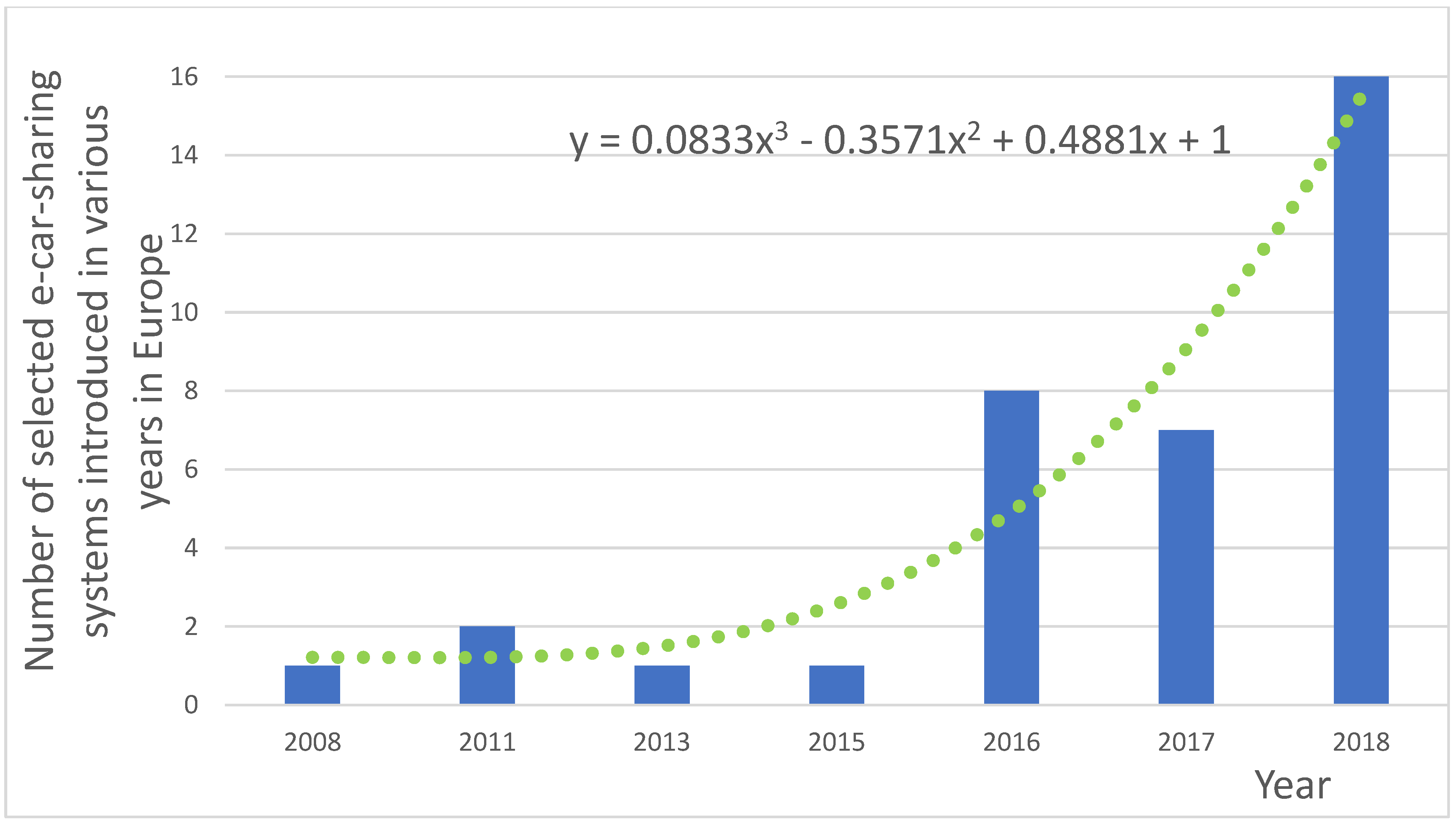
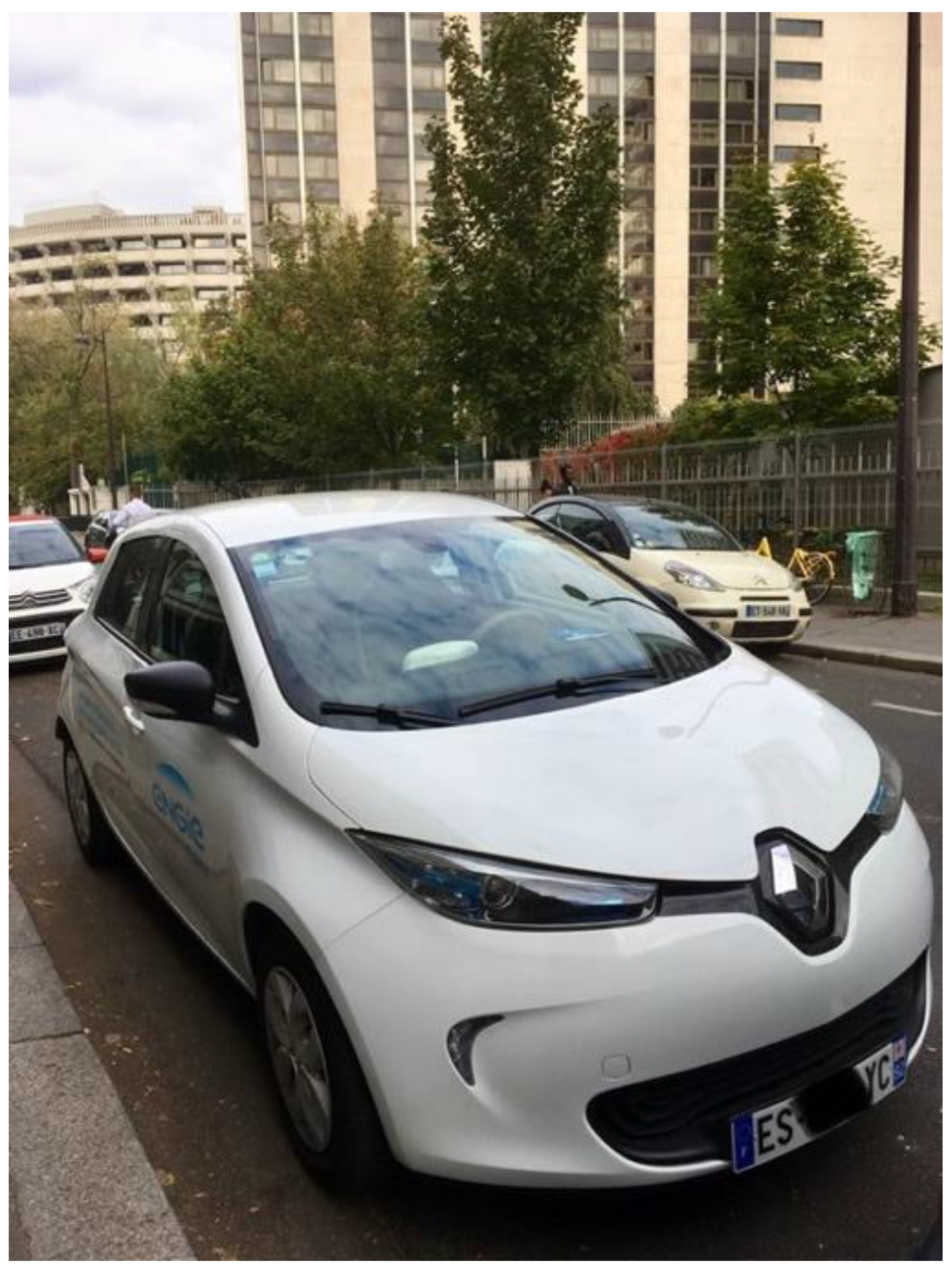
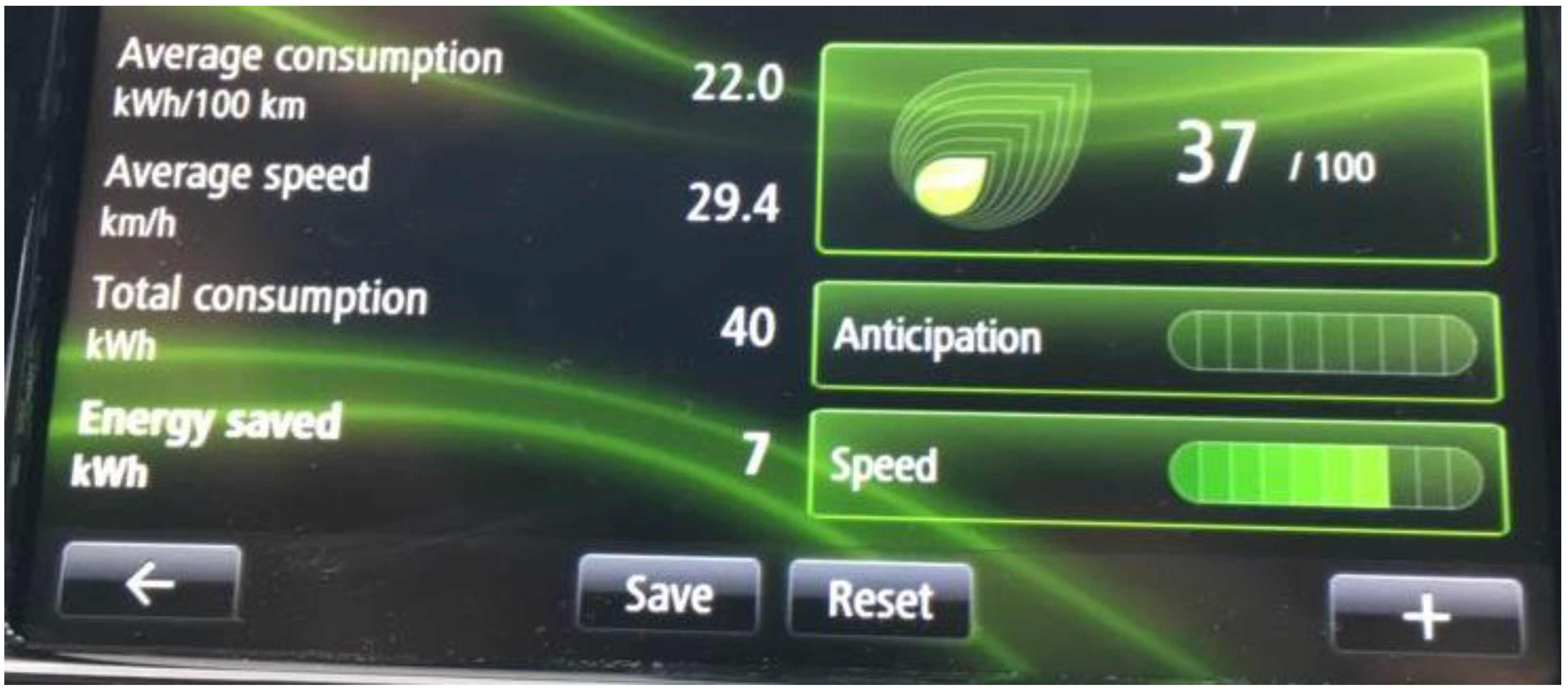
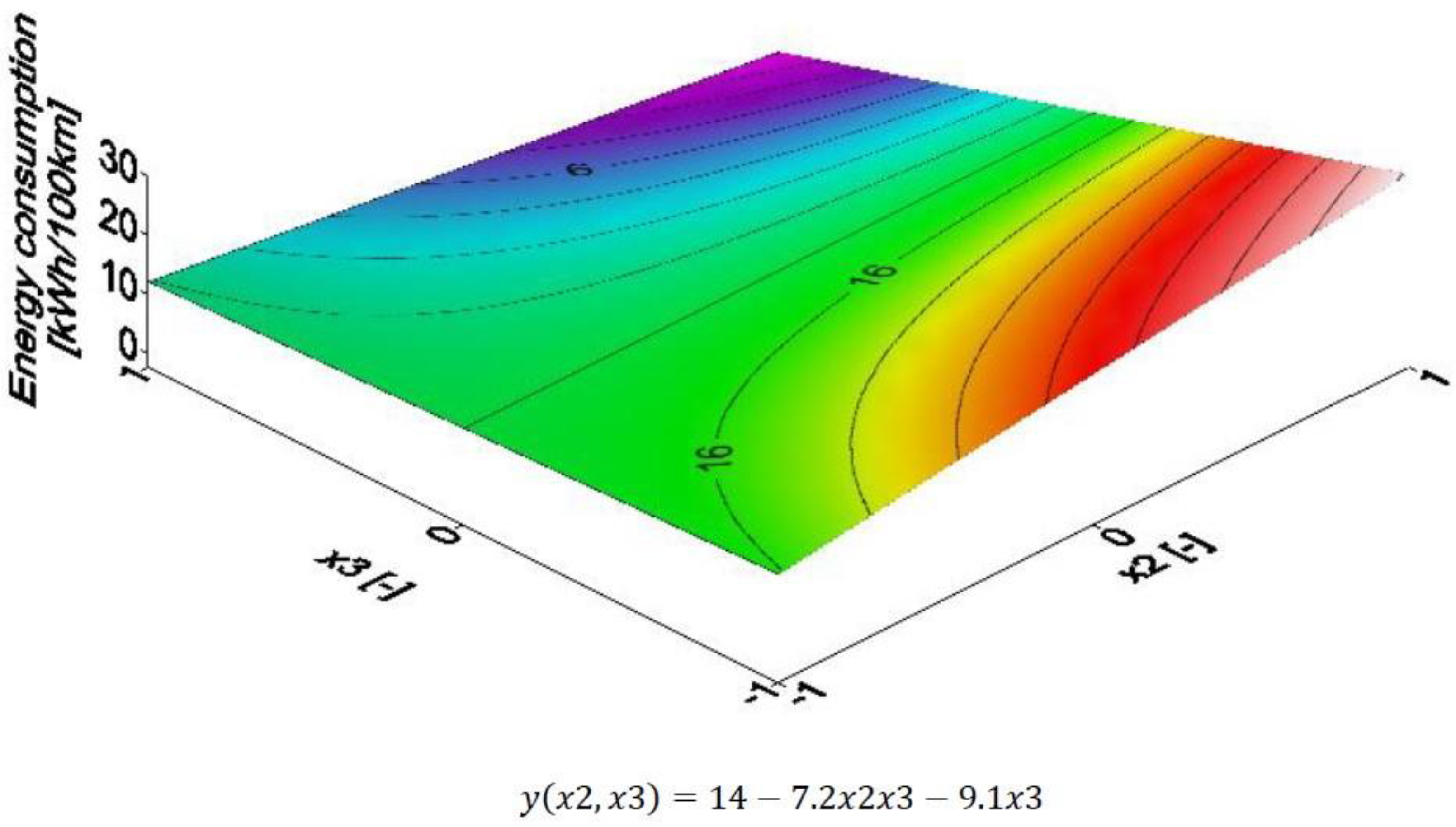
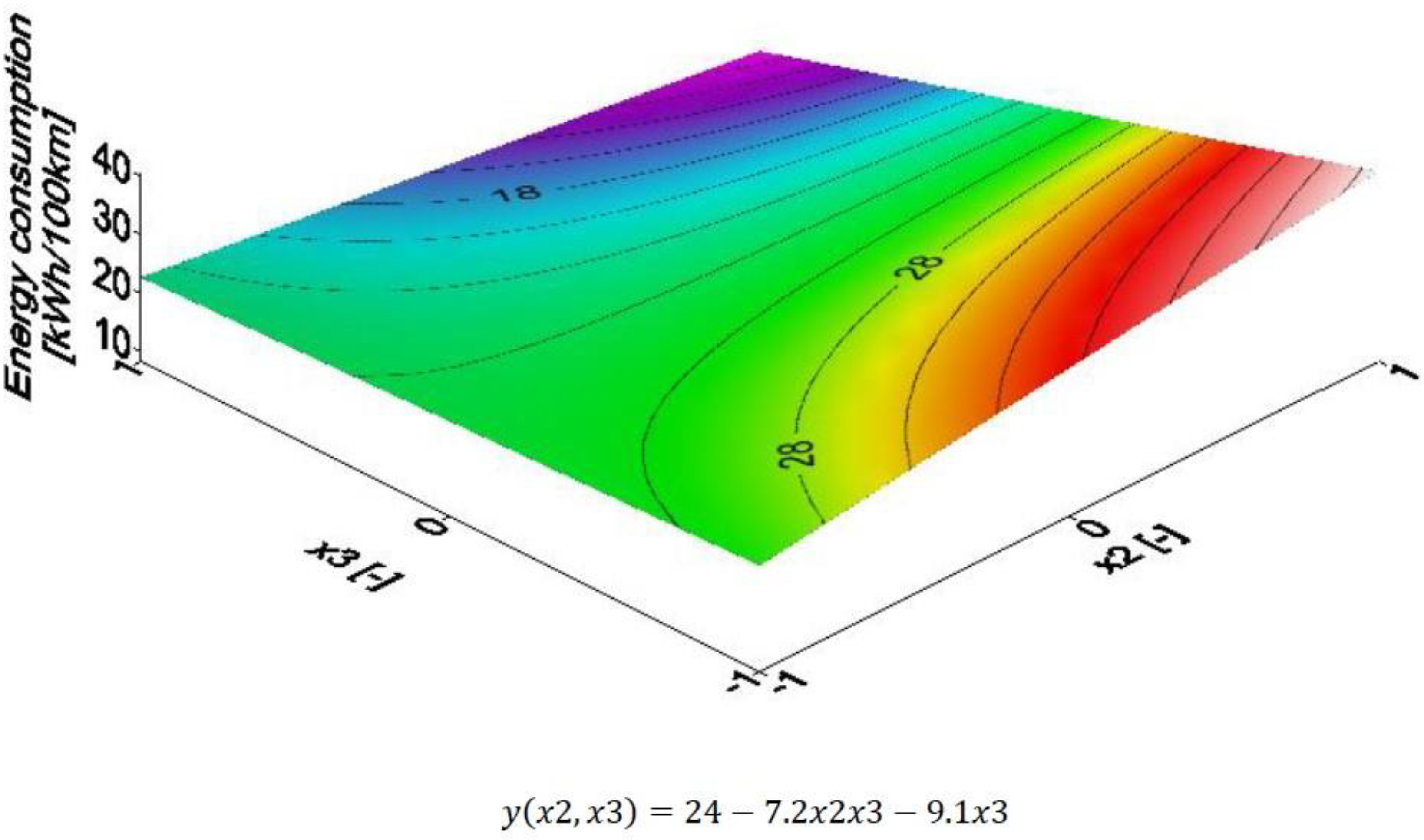
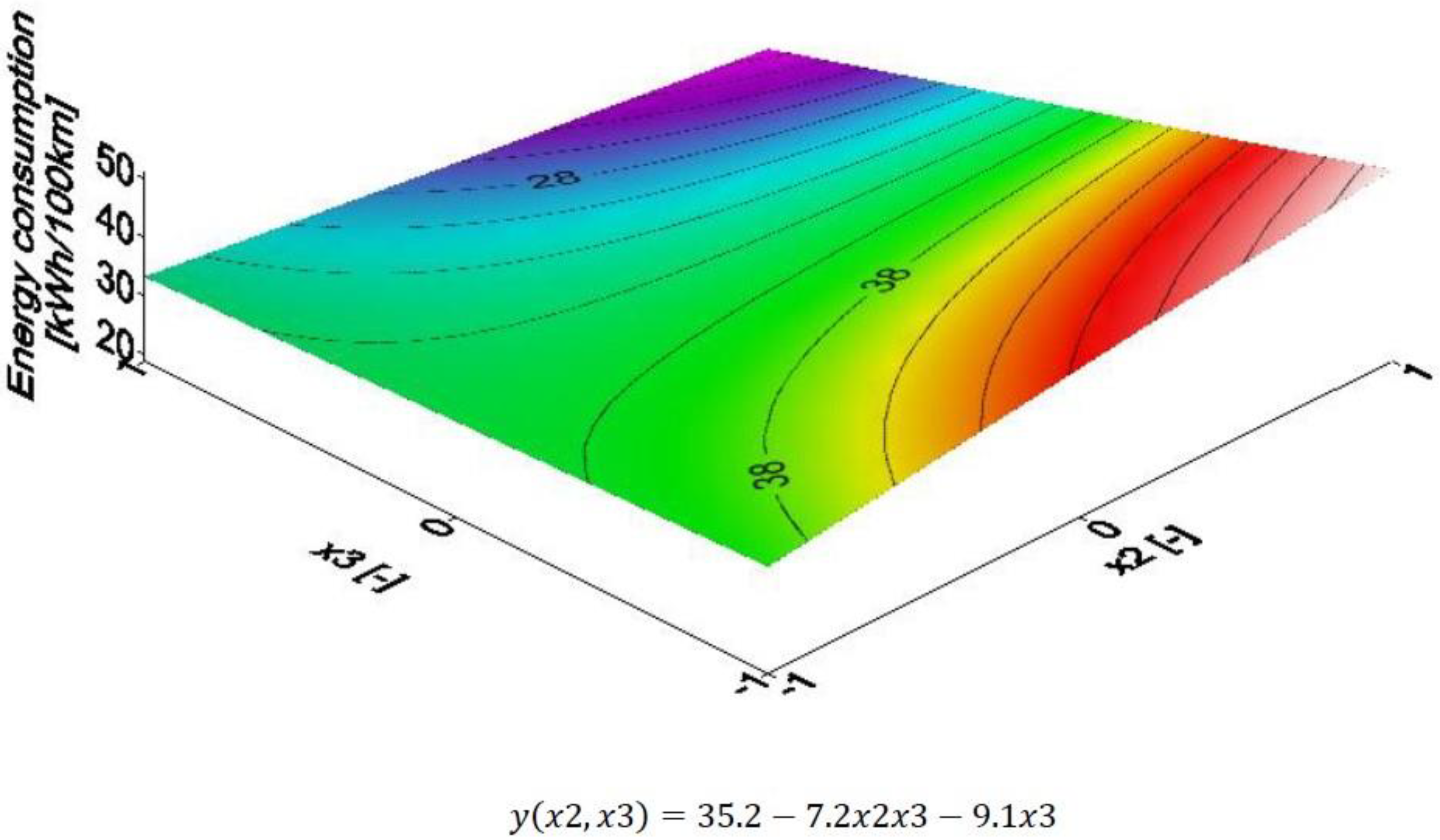
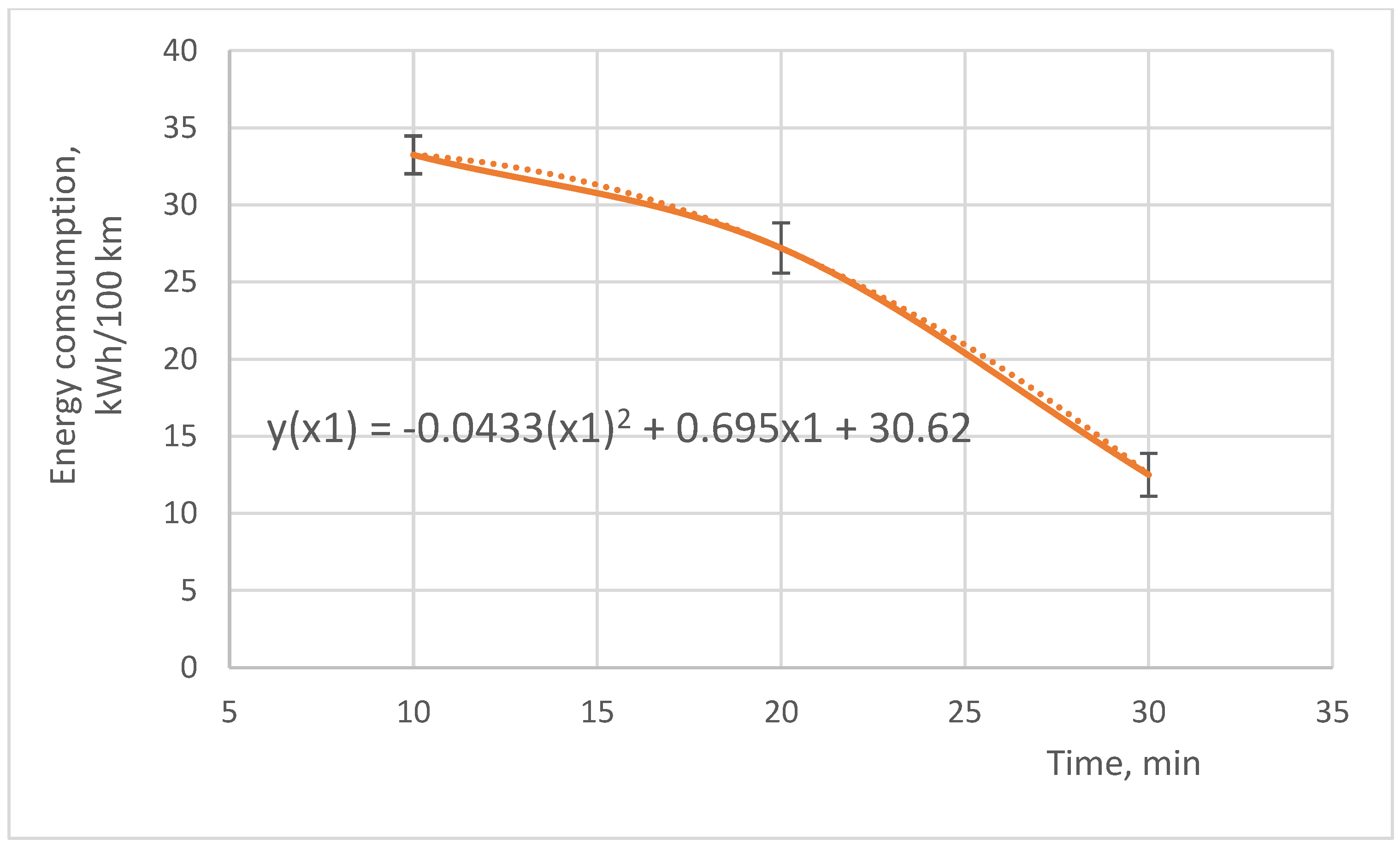
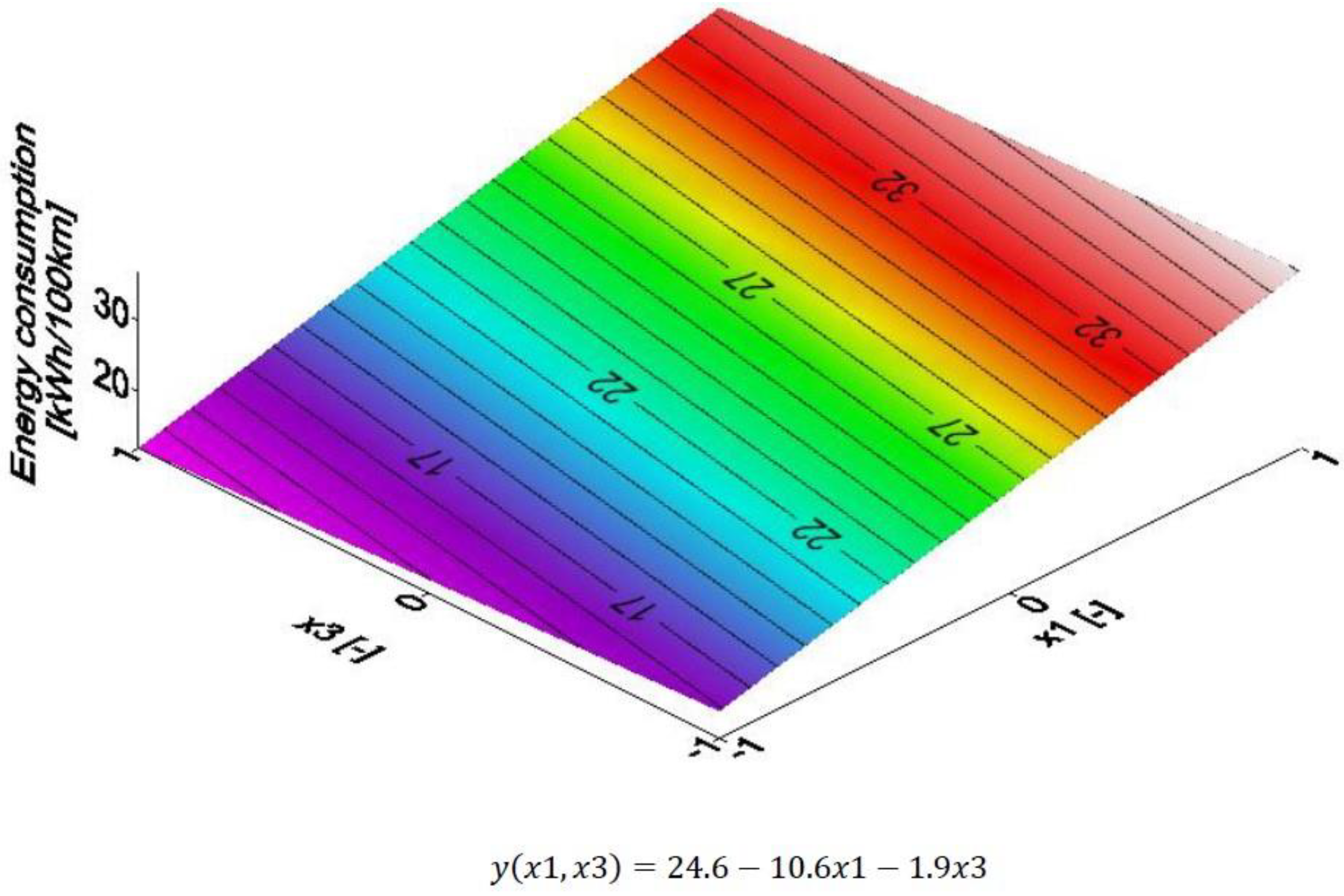
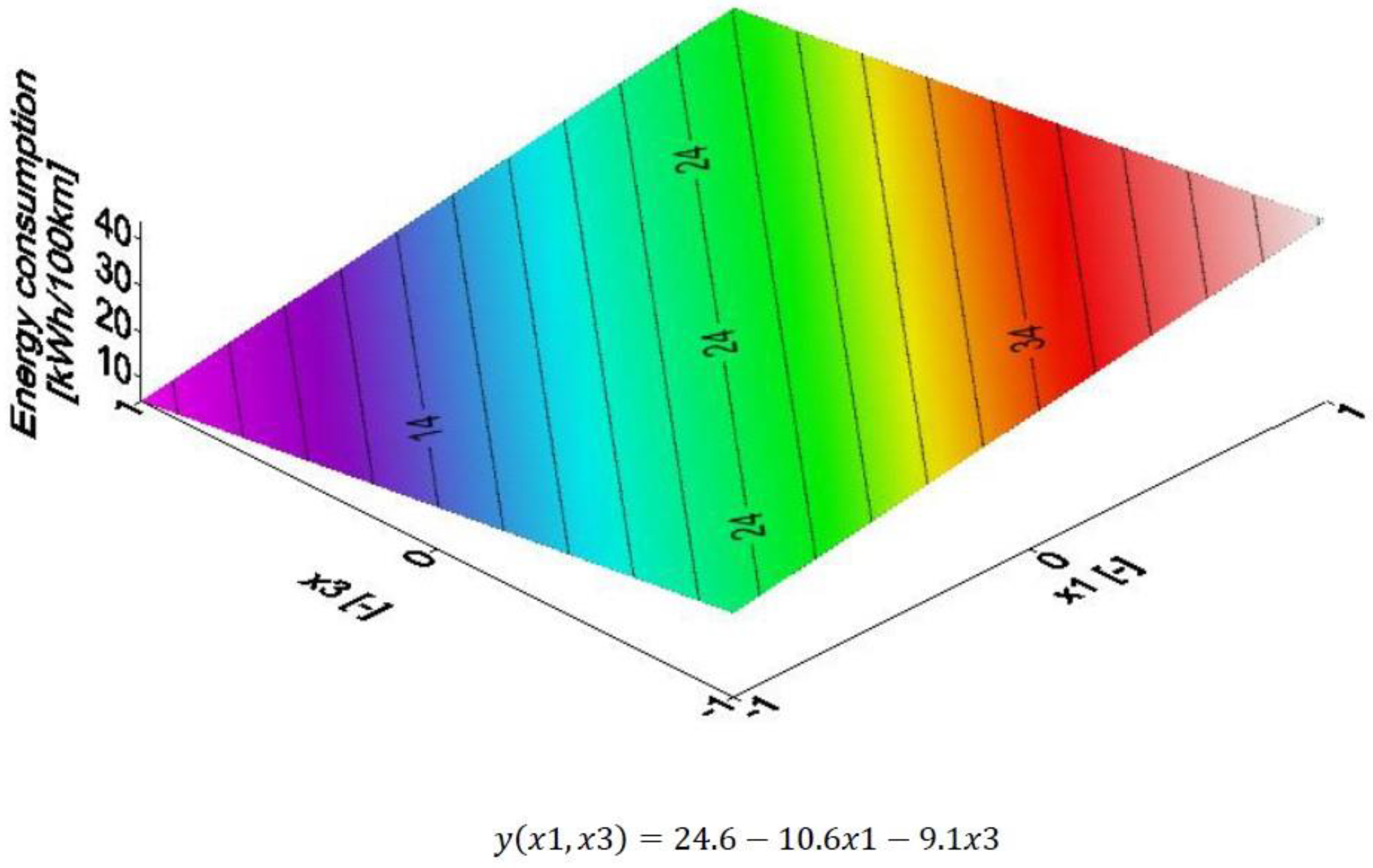
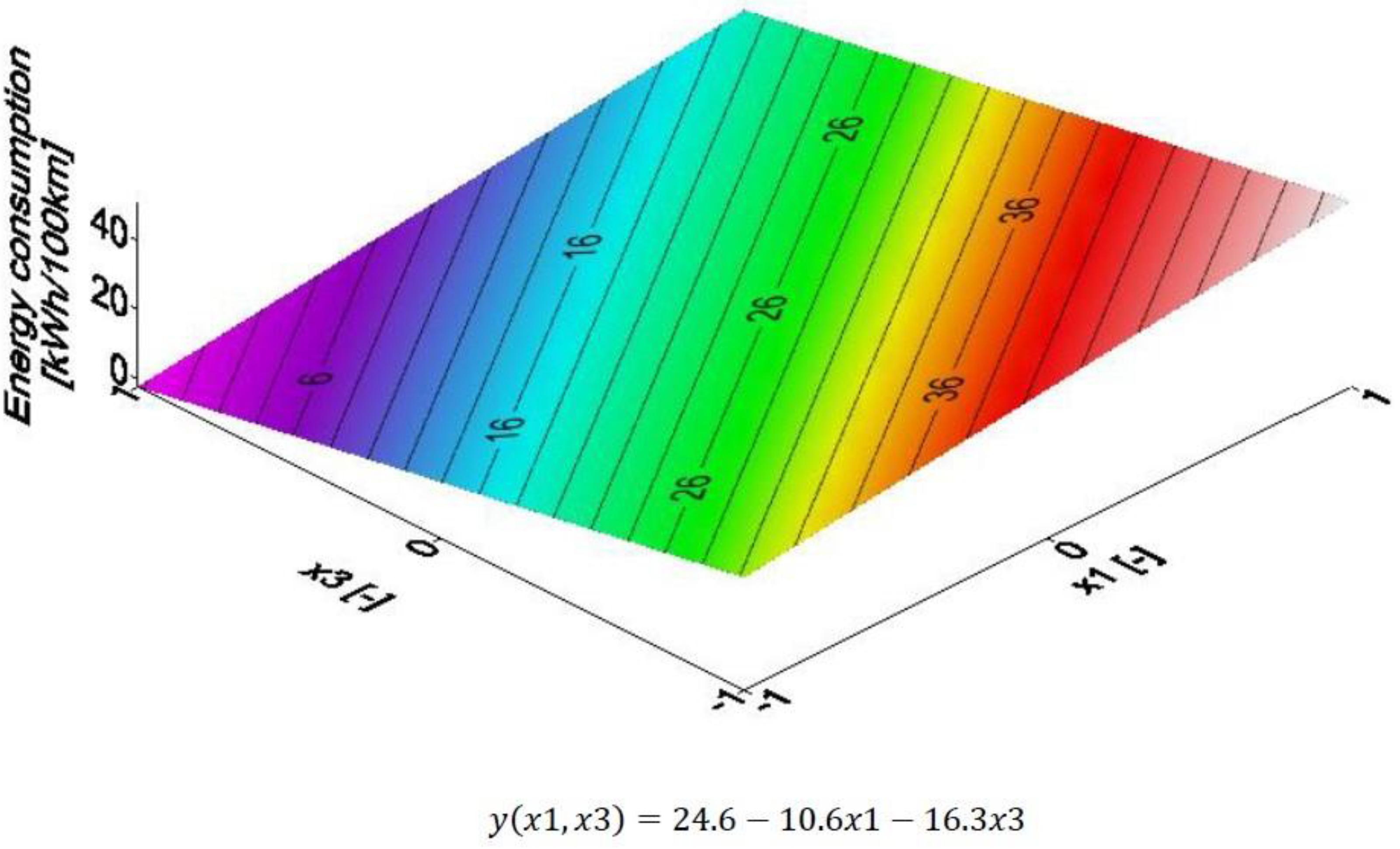
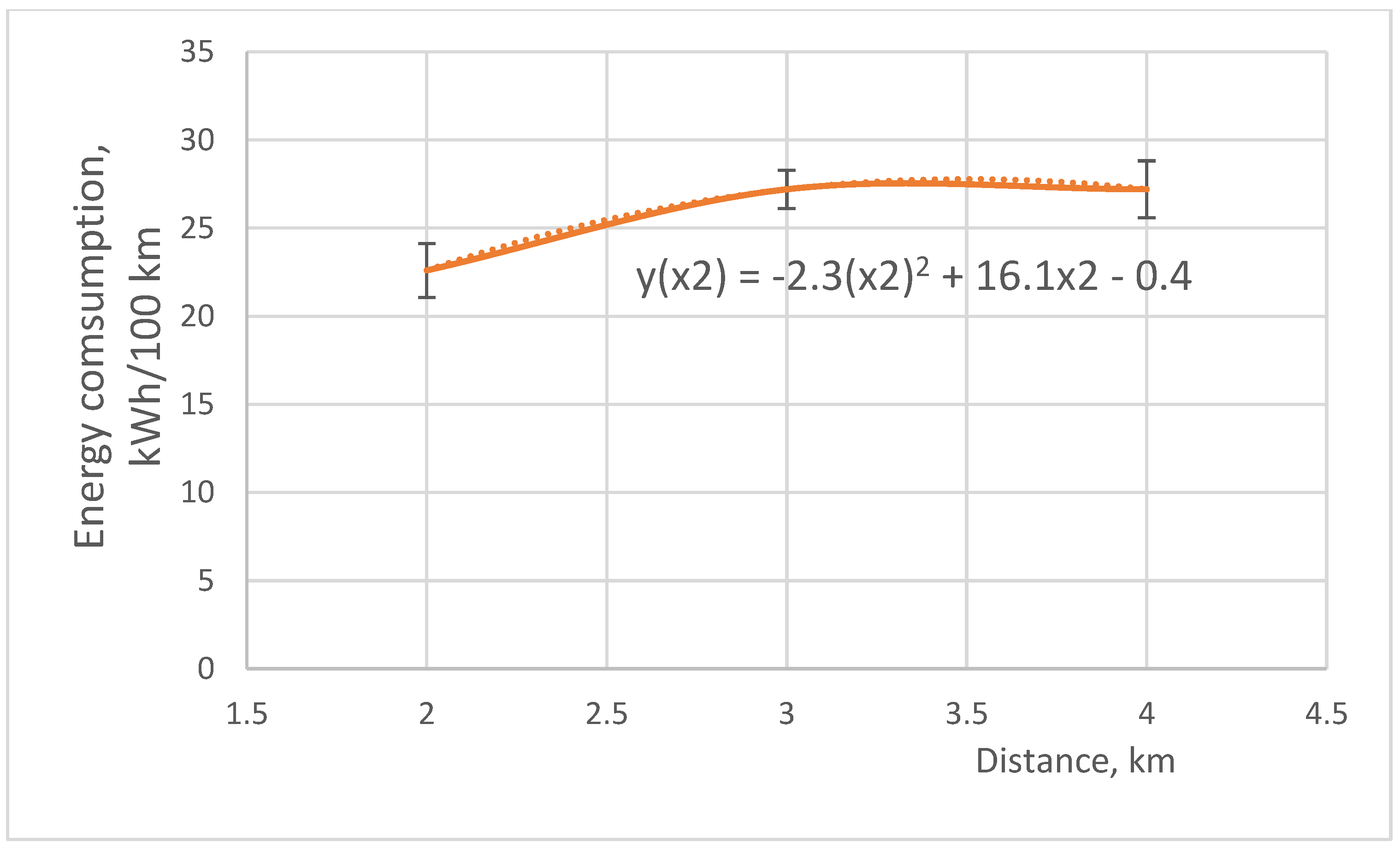
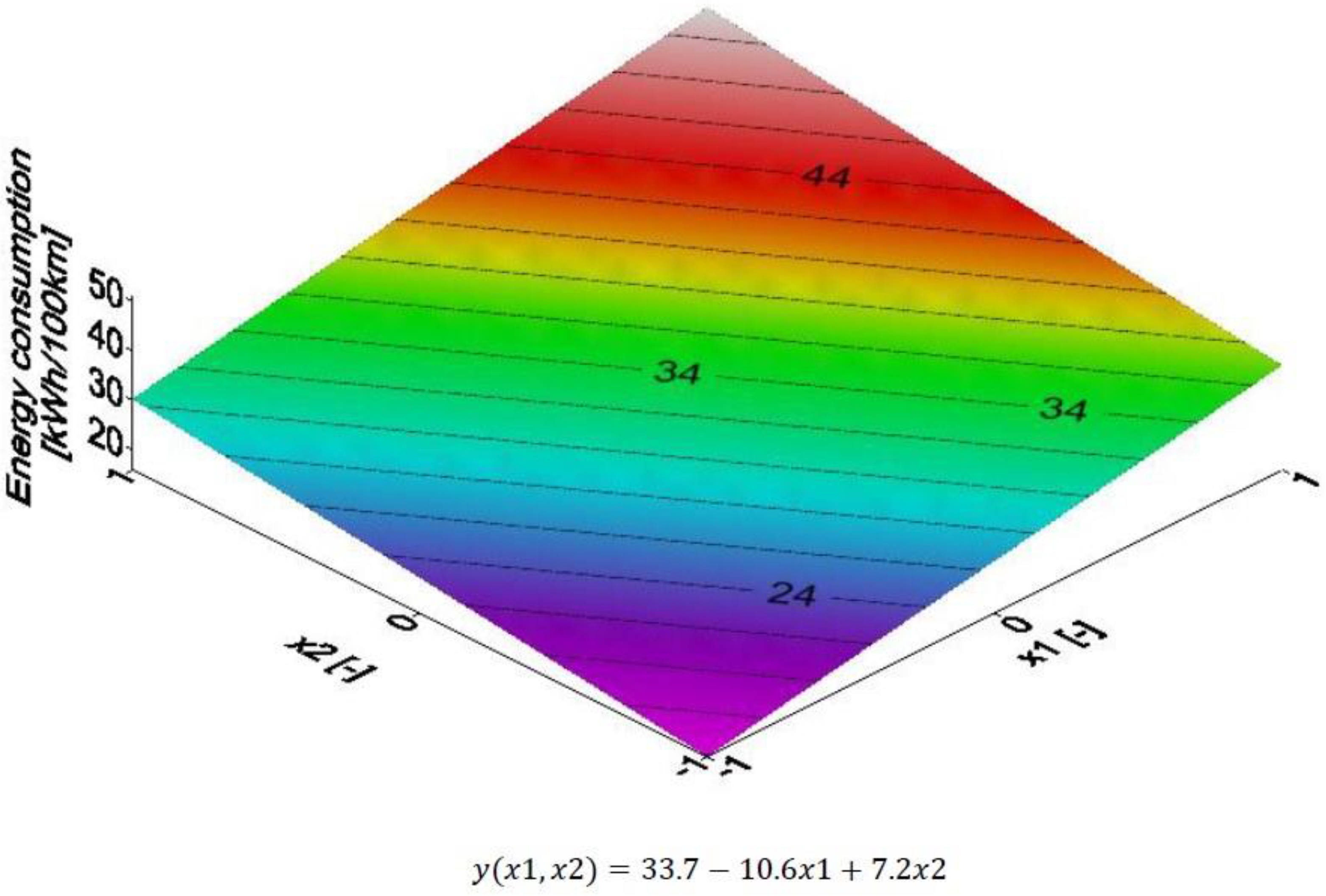
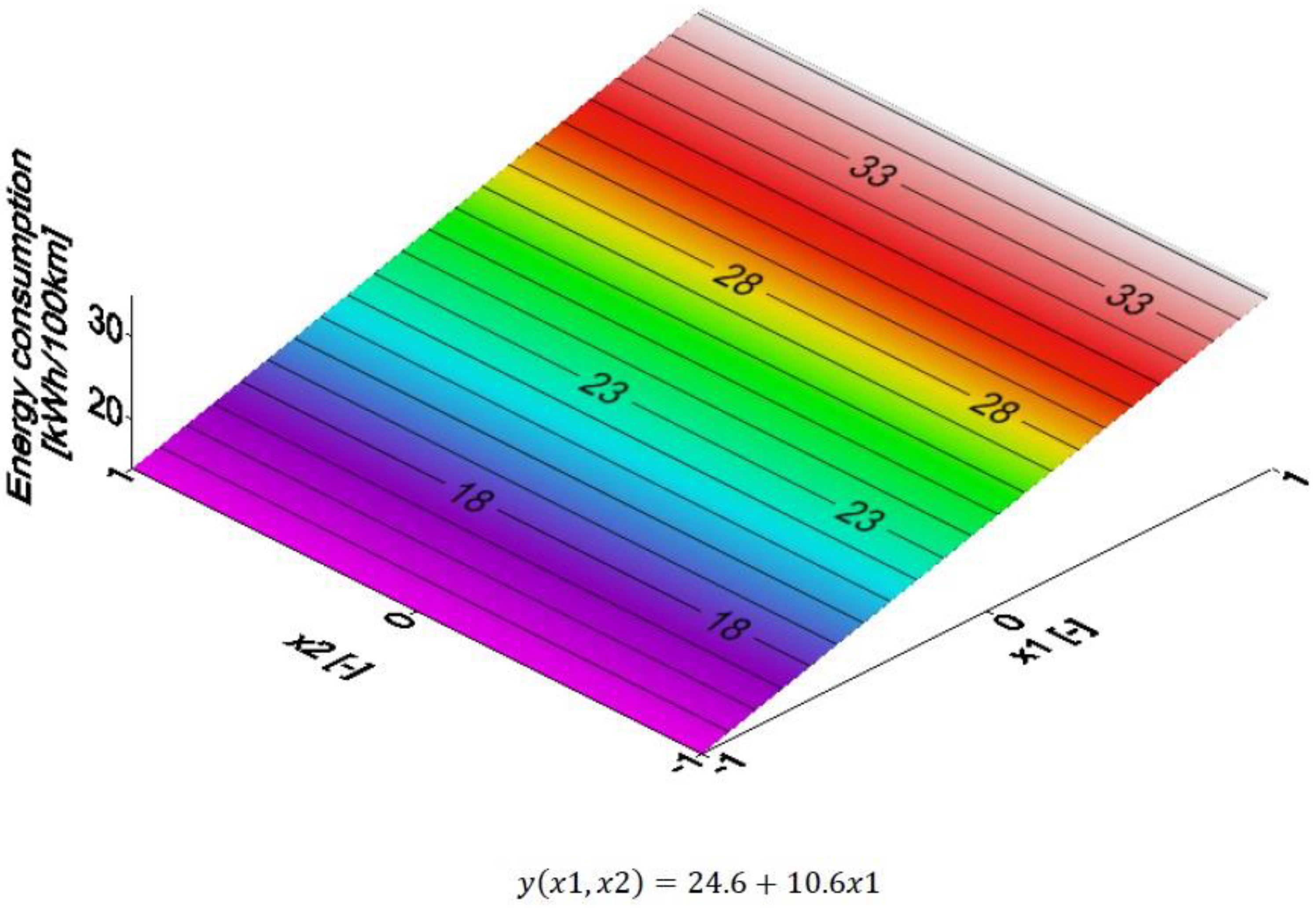
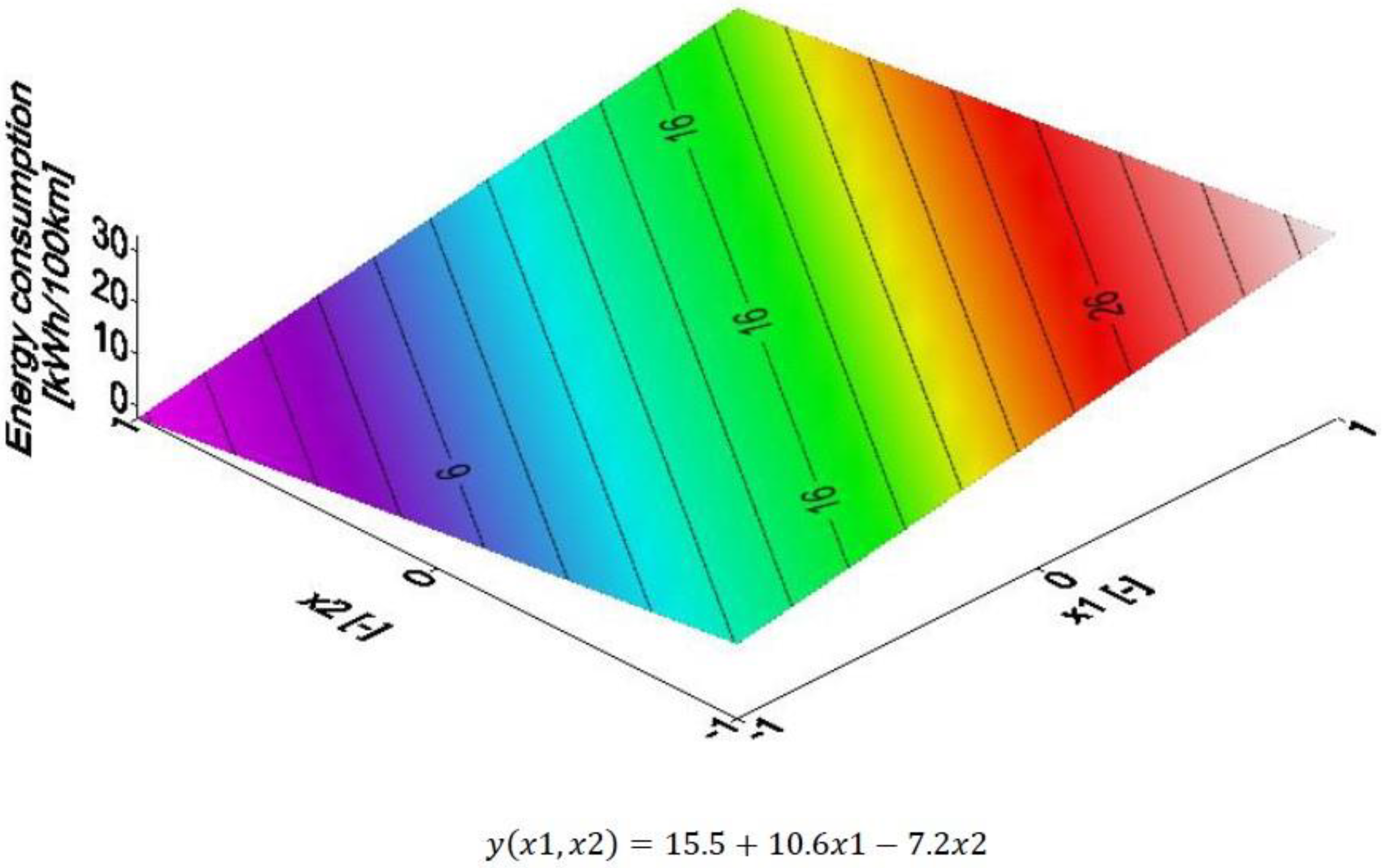
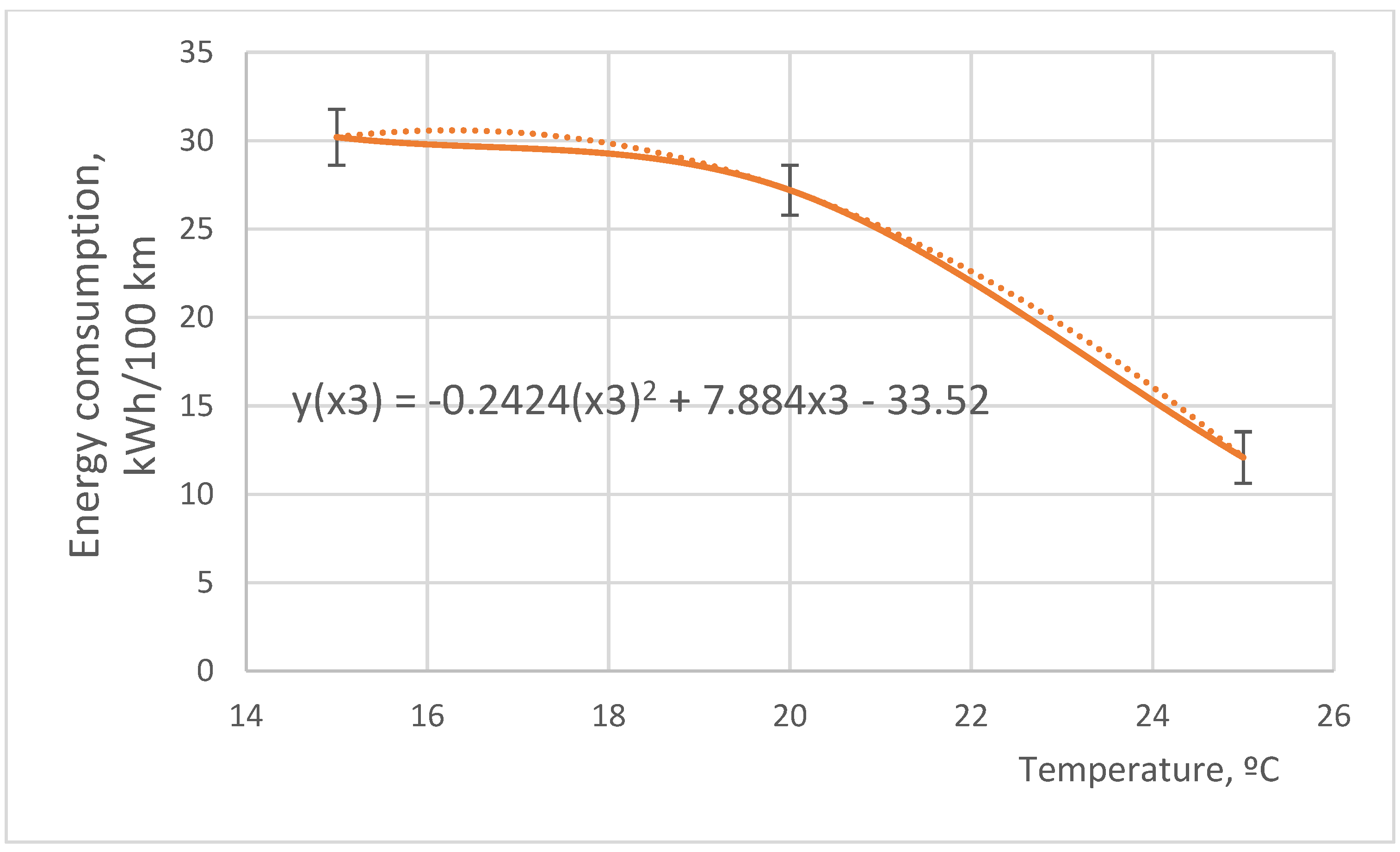
| Sample No. | Input Factors on the Standard Scale | ||
|---|---|---|---|
| x1 | x2 | x3 | |
| 1 | –1 | –1 | 1 |
| 2 | 1 | –1 | –1 |
| 3 | –1 | 1 | –1 |
| 4 | 1 | 1 | 1 |
| 5 | –α | 0 | 0 |
| 6 | α | 0 | 0 |
| 7 | 0 | –α | 0 |
| 8 | 0 | α | 0 |
| 9 | 0 | 0 | –α |
| 10 | 0 | 0 | α |
| 11 | 0 | 0 | 0 |
| Sample No. | Input Factors on a Standardized Scale | Real Scale Input Factors | ||||
|---|---|---|---|---|---|---|
| x1 | x2 | x3 | x1 Time (min) | x2 Distance (km) | x3 Temperature (°C) | |
| 1 | –1 | –1 | 1 | 30 | 2 | 25 |
| 2 | 1 | –1 | –1 | 10 | 2 | 15 |
| 3 | –1 | 1 | –1 | 30 | 4 | 15 |
| 4 | 1 | 1 | 1 | 10 | 4 | 25 |
| 5 | –α | 0 | 0 | 30 | 3 | 20 |
| 6 | α | 0 | 0 | 10 | 3 | 20 |
| 7 | 0 | –α | 0 | 20 | 2 | 20 |
| 8 | 0 | α | 0 | 20 | 4 | 20 |
| 9 | 0 | 0 | –α | 20 | 3 | 15 |
| 10 | 0 | 0 | α | 20 | 3 | 25 |
| 11 | 0 | 0 | 0 | 20 | 3 | 20 |
| Test No. | Energy Consumption, kWh/100 km | Standard Deviation |
|---|---|---|
| 1 | 13.6 | 0.5 |
| 2 | 36.3 | 2.0 |
| 3 | 21.5 | 1.0 |
| 4 | 13.6 | 0.8 |
| 5 | 12.5 | 0.5 |
| 6 | 33.2 | 2.0 |
| 7 | 22.7 | 1.0 |
| 8 | 27.2 | 1.4 |
| 9 | 30.2 | 1.8 |
| 10 | 12.1 | 0.7 |
| 11 | 27.2 | 1.5 |
© 2019 by the authors. Licensee MDPI, Basel, Switzerland. This article is an open access article distributed under the terms and conditions of the Creative Commons Attribution (CC BY) license (http://creativecommons.org/licenses/by/4.0/).
Share and Cite
Turoń, K.; Kubik, A.; Chen, F. Operational Aspects of Electric Vehicles from Car-Sharing Systems. Energies 2019, 12, 4614. https://doi.org/10.3390/en12244614
Turoń K, Kubik A, Chen F. Operational Aspects of Electric Vehicles from Car-Sharing Systems. Energies. 2019; 12(24):4614. https://doi.org/10.3390/en12244614
Chicago/Turabian StyleTuroń, Katarzyna, Andrzej Kubik, and Feng Chen. 2019. "Operational Aspects of Electric Vehicles from Car-Sharing Systems" Energies 12, no. 24: 4614. https://doi.org/10.3390/en12244614
APA StyleTuroń, K., Kubik, A., & Chen, F. (2019). Operational Aspects of Electric Vehicles from Car-Sharing Systems. Energies, 12(24), 4614. https://doi.org/10.3390/en12244614







